Review of Toyota Prado specifications
The Toyota Prado is one of the prominent and well-known models in the world of SUVs, produced by Toyota. This vehicle is particularly categorized as a luxury and versatile SUV, having attracted the attention of many customers worldwide by offering a combination of safety features, superior performance, and attractive design.
Toyota Prado is renowned as a reliable model for driving on rough roads and in difficult regions, providing both high power and performance, as well as comfort and convenient amenities for its passengers.
The history of Toyota Prado dates back to the 1980s when the first generation of this vehicle was introduced to the market as a smaller and more luxurious version of the Toyota Land Cruiser. Over time, with changing market needs, Toyota Prado has gone through several generations, continually improving in design, technology, and safety systems to offer a more up-to-date and efficient driving experience for its drivers.
When reviewing the specifications of Toyota Prado, in addition to considering the exterior design and interior features, factors such as engine power, four-wheel drive systems, advanced safety systems, and performance capabilities in various road and weather conditions should also be taken into account.
Due to its high ability for long-distance travel, driving in tough conditions, and fuel efficiency, this vehicle has become one of the popular choices in the global market. In the following, we will delve deeper into the features and technical specifications of Toyota to gain a better understanding of this successful and popular vehicle.
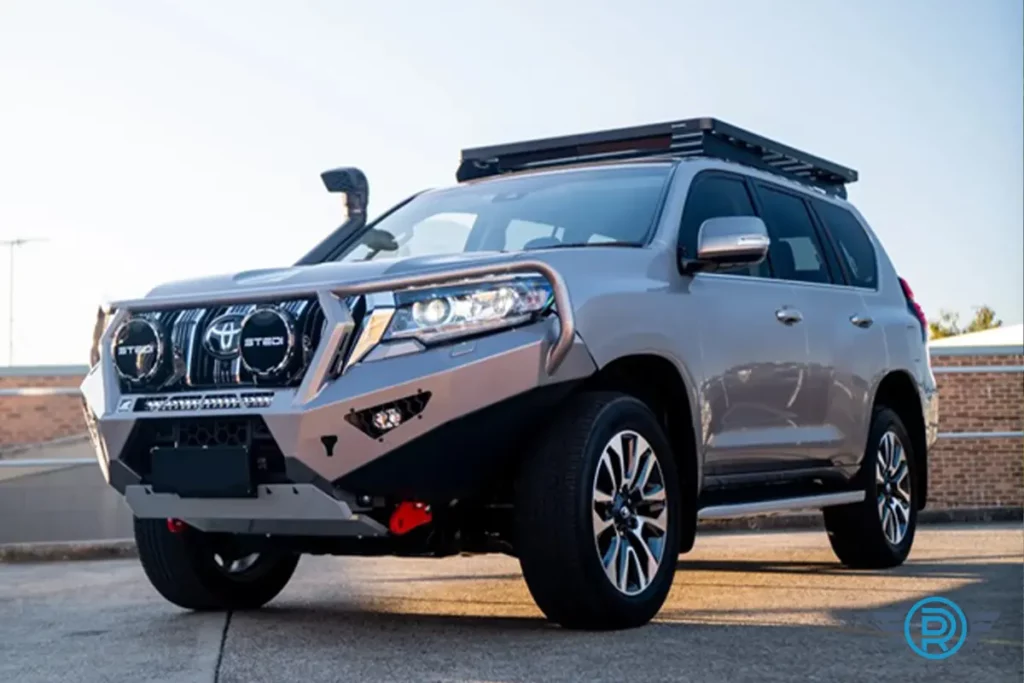
Various Prado generations
Toyota Prado is one of the popular SUV models produced by Toyota. Since its introduction in the 1980s, this vehicle has gone through several generations. Below, we will review the different generations of the Toyota Prado:
- First Generation (J70) – Introduction: 1984
The first generation of Toyota Prado was essentially introduced as a smaller, more luxurious version of the Toyota Land Cruiser. This generation was specifically designed for markets in Africa, Australia, and the Middle East, with features such as a four-wheel-drive system and a rugged body.

- Second Generation (J90) – Introduction: 1996
The second generation entered the market with an updated design and more features. This generation continued to use the Land Cruiser platform but became a more comfortable SUV for long-distance travel. A variety of diesel and gasoline engines were available for this generation.
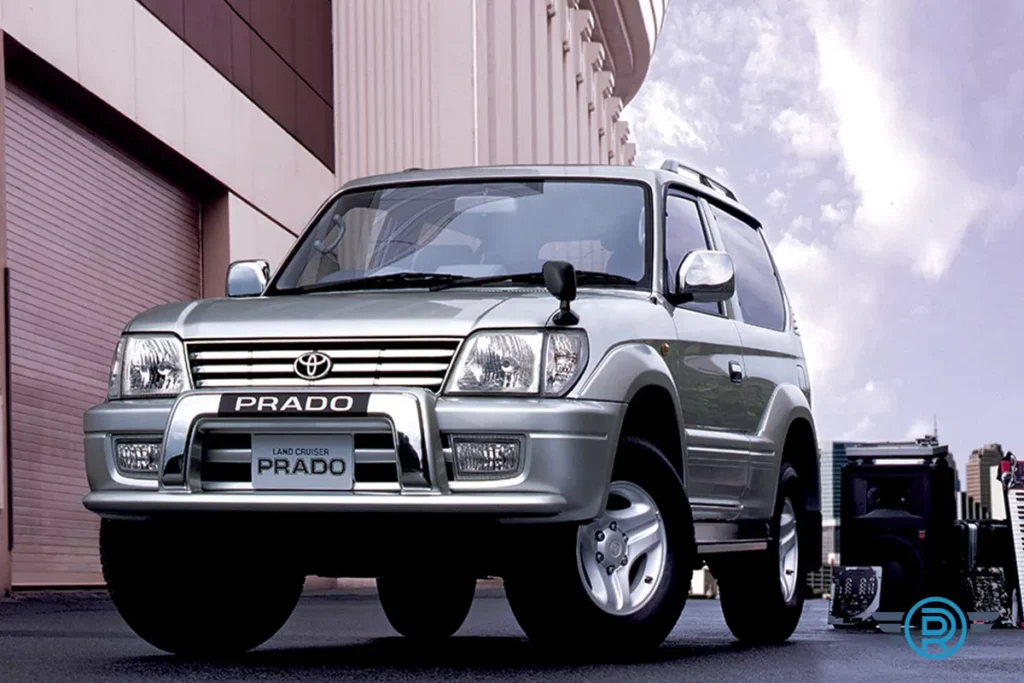
- Third Generation (J120) – Introduction: 2002
The third generation of the Prado came with significant changes in design and technology. More advanced safety systems were added, and its comfort features were greatly improved. This generation was designed primarily for global markets and easily captured the attention of many buyers.

- Fourth Generation (J150) – Introduction: 2009
In this generation, the vehicle’s exterior design became more modern and stylish, with new technical and safety systems, such as Anti-lock Braking System (ABS), traction control, stability control, and new air conditioning and entertainment systems. This generation focused more on comfort and stability on rough roads.
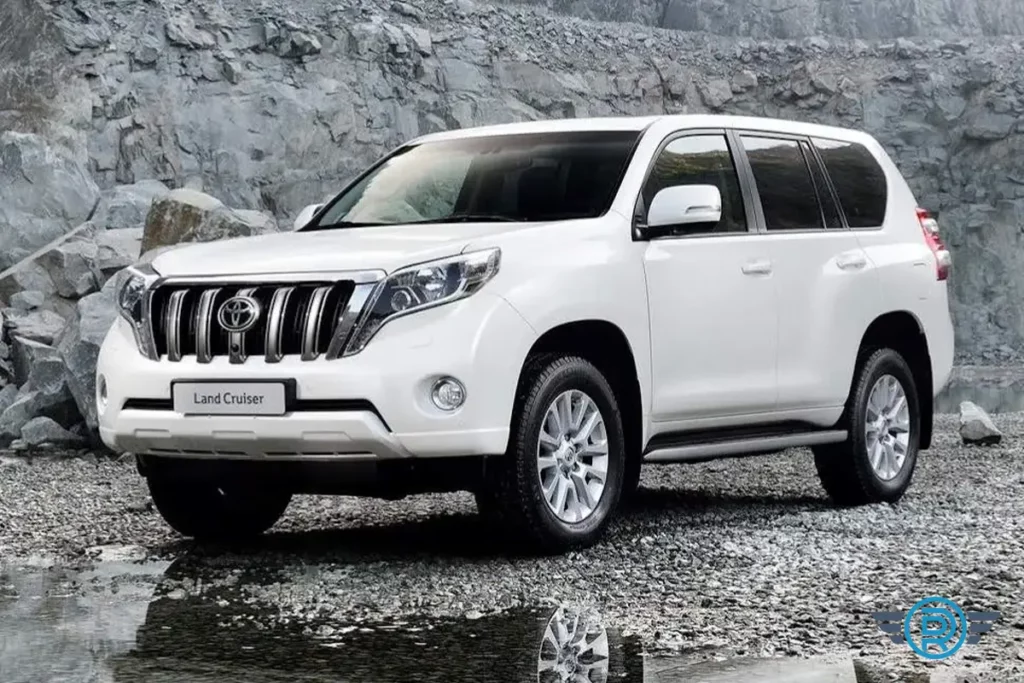
Review of Toyota Prado general specifications
Some Toyota Prado models feature two fuel tanks, which are referred to as single tank and dual tank. The second tank serves as a reserve or backup fuel tank and can be used in emergencies.
The Toyota Prado has three rows of seats; however, when the third row is used, there is very limited space available for luggage or suitcases.
In some models, the spare tire is located at the rear of the vehicle, while in other models, it is positioned underneath the vehicle.
The rear door of the vehicle, which serves as the trunk compartment, opens in a side-hinged manner (like a cabinet) to the left or right, and unlike many SUVs, it does not open upwards.
The rear window of the third row also opens a few centimeters in a side-hinged fashion, not in a sliding manner, allowing for air exchange.
Review of Toyota Prado technical specifications
The Prado, in addition to its gasoline models, was also produced in diesel versions in its older generations. However, like many imported cars, this vehicle has only been offered in its gasoline version in the Iranian market. The imported version of this car, which is primarily available in the market, is equipped with a naturally aspirated gasoline engine with a capacity of 3956 cc. This engine has 6 cylinders arranged in a V shape and 24 valves of the DUAL VVTI type.
The maximum output power of this engine is 271 horsepower, which is achieved at 5600 RPM, and its maximum torque is 381 Nm at 4400 RPM. Most of the Prado models available in the Iranian market are equipped with a four-speed automatic transmission or a five-speed manual transmission.
In general, vehicles with manual transmissions offer better acceleration. However, the Prado, whether in the manual or automatic version, provides acceptable acceleration.
Although the Prado has many strong points in terms of technical capabilities, it cannot be considered an efficient product in terms of fuel consumption. The average fuel consumption of this vehicle in combined conditions is about 12.5 liters per 100 kilometers. This figure is not particularly unusual for an SUV, but overall, it could be more optimized than its current state.
The same applies to the car’s emission standard, which is in Euro 3. However, the Prado performs well in terms of suspension and braking systems, and it efficiently handles its tasks.

Prado car exterior design
The Toyota Prado is one of the prominent SUVs, which has attracted the attention of many SUV enthusiasts with its attractive and durable exterior design. This vehicle is designed not only with aesthetics in mind but also to effectively handle rough roads and harsh conditions.
Front Design and Grille: In the front design, the Toyota Prado features a large, mesh grille that showcases its modern and stylish look. This grille, with horizontal lines and chrome accents, gives the vehicle a sporty yet powerful appearance. The angular and modern headlamps also add a sharp and aggressive look to the car. Additionally, the use of LED lights in various sections of the front adds a unique touch to the Prado’s appearance.
Body and Lines: In the body design, the Toyota Prado incorporates prominent and muscular lines that give the vehicle a powerful and sleek look. These lines are particularly visible on the sides of the vehicle and, when combined with tall and durable panels, create the appearance of an SUV ready to tackle difficult terrains. The vehicle’s body is highly resistant to impacts and tough road conditions, a feature that is especially important for off-road driving.
Rear Design: The rear design of the Toyota Prado maintains its simplicity and stylishness. In various models, the rear door opens sideways to the left and right, providing more convenience and ease for accessing the trunk. In addition, the rear lights are horizontally designed and feature a modern, powerful appearance that adds a sharp and attractive look to the vehicle. Furthermore, the spare tire is located at the rear in some models, which enhances the vehicle’s functional and utilitarian design.
Dimensions and Height: The Toyota Prado has a large size and an appropriate height, giving it a strong presence on the road. This feature not only improves the driver’s visibility but also allows the vehicle to easily pass over obstacles and challenging paths. The higher ground clearance also prevents the vehicle from hitting ground obstacles like rocks and uneven roads.
Wheels and Rims Design: The wheels and rims of the Toyota Prado play a significant role in the vehicle’s exterior design. It is equipped with large, durable rims capable of handling the pressures of off-road roads. The design of these rims is typically such that it combines both performance and aesthetics, resulting in an excellent balance of functionality and beauty.
Toyota Prado interior design
The interior of the Toyota Prado is designed with the goal of providing comfort, luxury, and high functionality for passengers. As a luxury SUV, this vehicle offers a combination of modern features, spaciousness, and the use of high-quality materials, providing a comfortable and enjoyable driving experience.
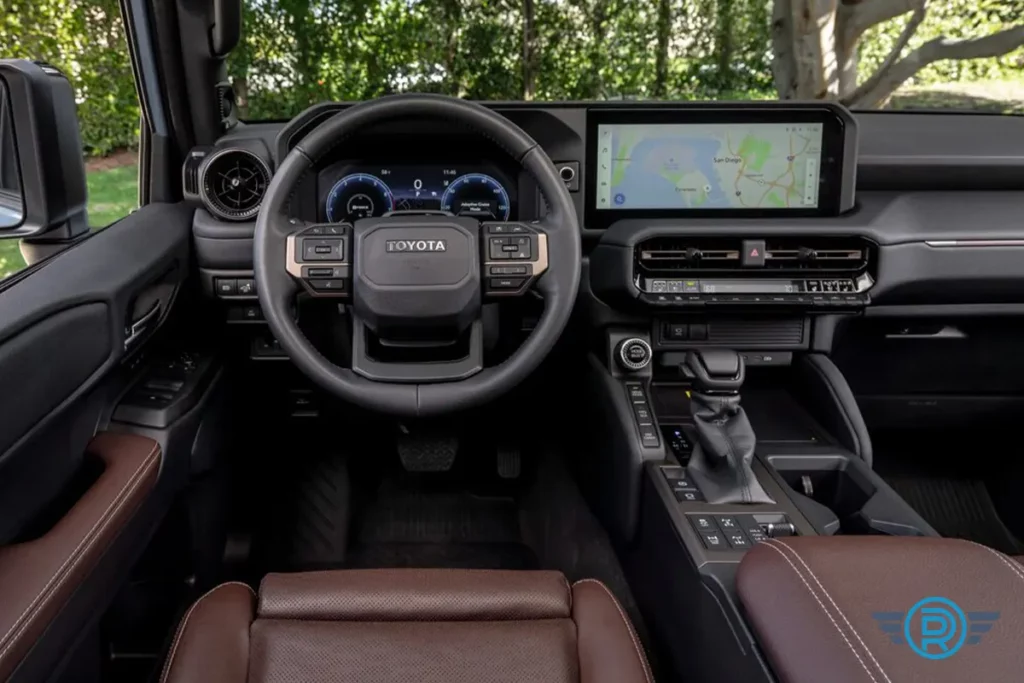
- Dashboard and Center Console Design: The dashboard of the Toyota Prado is designed to be modern and user-friendly, ensuring that all controls are easily accessible to the driver. The use of high-quality materials, such as soft plastics and leather trims in some models, enhances the luxurious feel of the cabin. The center console features a large touchscreen display and an advanced navigation system, offering a comfortable driving experience for both the driver and passengers.
- Seats and Interior Space: The seats in the Toyota Prado are designed to be very comfortable and ergonomic. Depending on the model, the seats are upholstered in either leather or fabric, ensuring long-lasting comfort during long trips. The front seats are electrically adjustable, and in some models, there are also heated and ventilated seats available. The second-row seats offer ample space for passengers, and even when using the third-row seats, passengers in the second row are still very comfortable. The third-row seats are particularly suitable for children or shorter passengers, but when these seats are in use, the trunk space becomes limited.
- Entertainment and Audio Systems: The Toyota Prado is equipped with advanced entertainment systems, which include a large touchscreen display, a high-quality audio system, and Bluetooth and USB connectivity options. These systems not only allow for music and video playback but also easily connect to smartphones, offering a modern and user-friendly experience for passengers.
- Cargo Space and Practicality: The Toyota Prado features a smartly designed interior that offers a sufficient cargo space for carrying luggage and other items. The rear trunk is specifically designed to carry heavy and large loads, and if needed, the third-row seats can be folded down to provide additional cargo space. In some models, there are additional features like hidden storage compartments throughout the cabin, which can help with carrying smaller items.
Features and capabilities of the Prado
The Prado vehicle is equipped with a range of advanced systems to enhance stability and control. Anti-lock Braking System (ABS) and Electronic Brakeforce Distribution (EBD) are among the features commonly seen in many modern cars, making their presence in the Prado not unexpected. Additionally, the vehicle is equipped with complementary systems such as ATRC. Other features designed to improve stability, control, and intelligent vehicle guidance include:
Brake Assist System (BAS)
Vehicle Stability Control (VSC)
Traction Control System (TRC)
Dynamic Vehicle Stability Control Management System (VDIM)
Downhill Assist Control (DAC)
Hill-start Assist Control (HAC)
Intelligent Cruise Control System

To ensure the safety of its occupants, the Prado is equipped with a large number of airbags, including driver airbag, front passenger airbag, curtain airbags, knee airbags for front passengers, and side airbags for both front and rear occupants. Additionally, the vehicle allows drivers to choose between three different driving modes: Normal, Sport, and Eco (for optimizing fuel consumption).
The Prado also features smart keyless entry and a push-start button, eliminating the need for a traditional key to interact with the vehicle. In terms of comfort features, the Prado performs exceptionally well. Undoubtedly, its most prominent comfort feature is its entertainment system, which includes a 9-inch display in the front cabin. Rear passengers also benefit from a dedicated screen.
This entertainment system is equipped with a relatively advanced audio system. It supports AM and FM radio, Bluetooth connectivity, and is capable of playing MP3 and DVD files. Additionally, it includes USB, AUX, and iPod-specific ports. Below is a list of other key features and specifications of the Toyota Prado:
Rear parking sensors
Rearview camera with display on the main vehicle screen
Equipped with seatbelts and an immobilizer anti-theft system
Central locking system
Tire pressure monitoring system
Electric seat adjustment for both driver and front passenger
Seat cooling functionality for driver and front passenger seats
Leather upholstery
Electrochromic rearview mirror
LED low and high beam headlights
Automatic headlight activation
Daytime running lights and fog lights
Rain sensor
Wiper timer
Electric windows
Turn indicators on the headlights
Sunroof
Cooler compartment
Electric tailgate
This collection of features makes the Toyota Prado a well-equipped and comfortable vehicle for a wide variety of driving conditions, combining safety, convenience, and luxury.
Advantages and disadvantages of the Prado car
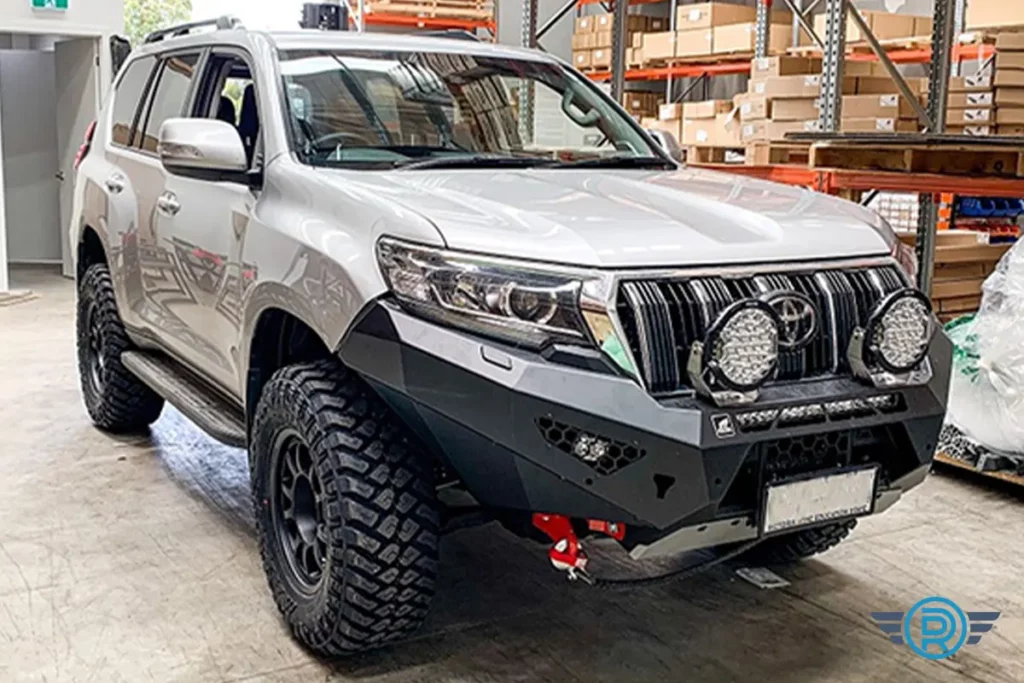
Among the advantages of the third generation, one can mention high build quality, durability of parts, a quiet cabin, off-road capability, relatively affordable spare parts, low depreciation, optimized fuel consumption, strong air conditioning system, after-sales service, and ample interior space for passengers, even in the 2-door model, as well as a reasonable second-hand market.
Regarding the disadvantages of the third generation, the vehicle’s handling is generally acceptable; however, due to the absence of traction control and slight weaknesses in the suspension system in the 4-cylinder models, body roll increases at high speeds, and the risk of rollover exists.
The fourth generation vehicles come with advantages such as stability control, traction control, softer suspension systems, and anti-rollover features, addressing the flaws of the third generation. Additionally, this generation offers more modern comfort features and equipment.
As for the disadvantages of the fourth generation, one can point out the removal of fender and door shock absorbers, inadequate acceleration, limited trunk space in the 2-door model, and the use of the previous generation’s engine and gearbox.
final word
The Toyota Prado is one of the prominent SUVs, known for its robust design, high build quality, and excellent off-road capabilities. Over the years, it has consistently offered advanced safety systems, optimized fuel consumption, spacious interiors, and modern amenities for both drivers and passengers.
Among the advantages of the Prado are its powerful engine, strong suspension and braking systems, excellent after-sales service, and comfortable cabin space for passengers. Additionally, the vehicle is recognized for its durable parts and reasonable resale value in the second-hand market.
However, despite all its advantages, there are some drawbacks in certain generations. Specifically, the third generation had issues with its suspension system and handling, which caused body roll and an increased risk of rollover at high speeds. In the fourth generation, features like poor acceleration and limited trunk space in the two-door models were noted.
Nevertheless, the Toyota Prado remains one of the best SUVs on the market, offering a combination of power, comfort, and technology, making it an excellent choice for driving in various road conditions.




































 Rolls Royce
Rolls Royce Lexus
Lexus Lamborghini
Lamborghini Porsche
Porsche Ferrari
Ferrari Toyota
Toyota Mercedes Benz
Mercedes Benz BMW
BMW Land Rover
Land Rover Bentley
Bentley Nissan
Nissan Cadillac
Cadillac Audi
Audi Chevrolet
Chevrolet GMC
GMC Hyundai
Hyundai Kia
Kia Mazda
Mazda